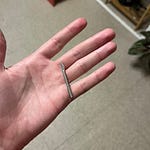Recently, a friend told me about having a vitamin deficiency that occasionally caused her heart to race for no reason. She re-enacted her confusion for me, hand over her breast in nonplussed pantomime. “Am I having a panic attack?” she would wonder, the sanguine mystery spasming under her fingers. Since starting some kind of supplement, her heart now behaves as it should.
Someone on Twitter recently linked me to the Wiki for misattribution of arousal, which is the process “whereby people make a mistake in assuming what is causing them to feel [sexually] aroused.” It’s a concept with which I’m acquainted, though I didn’t know it had a Wiki (a source we’ll be treating here as more or less unimpeachable because this newsletter is free1). “The reason physiological symptoms may be attributed to incorrect stimuli,” the page goes on, “is because many stimuli have similar physiological symptoms such as increased blood pressure or shortness of breath.”
As people who do SM, we recognize intuitively that feelings like fear, shame, and physical suffering, in their physiological resemblance to sexual and other kinds of arousal, can be deliciously generative proxies for horniness. This is not because the latter is by definition more palatable than other, more negative affects, but rather because, in this imperfect world, pleasure is not always as accessible or as easy to define as we’re led to believe. (The pain/pleasure binary is fake. I’m always saying this.) We recognize too, perhaps also intuitively, the limitations of this concept of misattribution of arousal: How can desire be “incorrect?” How can it be said to be more or less real or authentic based on the conditions of its arrival? How can it be meaningfully studied with uninterrogated and undefined terms like “arousal,” “attractive,” “romantic,” “sexual,” and even “sex?” (By and on straight [very likely white] men, no less.) In this framework, desire is a tangible thing, a token of a specific shape that has a corresponding “correct” receptacle that can’t be jammed into any other receptacle unless you break it, prize it open, and shove it inside. (Hot.)
Readers of DAVID know that SM is my preferred metaphor, but in thinking about the limitations of desire as it’s conventionally understood, it doesn’t have to be. When I was in high school, my cross-country running team wore shirts that said Pain is weakness leaving the body. When we traveled for meets, I took careful note of the proto-masochist slogans worn by competing teams, stuff like Our sport is your sport’s punishment. In the hierarchy of high school athletics, our sport—underfunded, co-educational, low on the cooperative dynamic that makes watching teams so enjoyable for some people—hovered somewhere around tennis, just a few inches above Academic Decathlon2. We defined ourselves more by our willingness to suffer than excellence or triumph or sportspersonship, finding the pleasureful emotional backwash of perversity, defiance, spite, and arrogance. The pleasure we took in our physical discomfort was not from the infamous runner’s high, but the recognition that as athletes we were, in a way, more than one flavor of loser. After all, only one person can win a race.
But back to SM. This newsletter reveals to me, over and again, that what distinguishes sadomasochism from everything else is not its bucking of sensory convention, but rather the communities and movements it tends to umbrella (for the past century or so, anyway). The “problem” with contemporary SM, or leather, is not that its violence is ambiguous or toxic, but rather that it creates spaces where marginal people build solidarity and sometimes even feel good. It accomplishes this by upending what we take for granted about desire, a project that we are trained to see as debased—even cringe—while accepting without a second thought the real debasement of a culture that finds genuine, reciprocal desire to be more frightening than random cruelty.
I did not always know this, of course. As a teen, I read Perez Hilton’s vicious little blog every single day. I regularly watched Cops and Intervention and other morally implicated reality shows, not bothered enough by the spectacle of others’ humiliation and pain to stop myself from being entertained by it. In the early aughts, I indulged with gleeful, morbid pity a series of short documentaries about objectum sexuality3, whose subjects were people who fucked, fell in love with, and sometimes even married inanimate objects. It wasn’t the heterosexual relationships all around me, poisoned with patriarchy, infiltrated by the constraints of survival under capitalism, limited by cisheterosexist understandings of sexual pleasure, and leeched of solidarity that were perverted. No, no, the real freaks were the people taking earnest comfort and sexual pleasure in a car, a picket fence, the Eiffel Tower. They weren’t hurting anybody. Who fucking cares?
I am changing. Once one has begun to interrogate one’s desire and one’s cruelty—a process that can only be done in tandem, I think—one begins to see the shocking artifice of normative pleasure, and the way it so seamlessly circumscribes what it means to feel good, what it means to want. I was reminded of this by Robin Craig’s recent primer on the fetish, an introduction to the concept that is arguably the example par excellence of the misattribution of arousal.
In Freudian terms, fetishes are about object worship and, as much as I dislike the majority of Freud’s work, our cultural understanding of fetish is heavily derived from his writing. In his 1927 essay ‘Fetishism’, Freud describes how a fetish is an object that replaces the mother’s penis, writing that “the fetish is a substitute for the woman’s (the mother’s) penis that the little boy once believed in and - for reasons familiar to us - does not want to give up.” Men fuck shoes, according to Freud, because they lean on their mother’s shoes when looking up her skirt and realising she does not have a penis, and therefore the shoe or foot becomes a manifestation of his protection from castration, a symbolic dick.
The fetish as a normative4 category of sexual object worship makes no room for nonsexual object worship; a broad, fluid, and dynamic erotics that can be both sexual and not sexual simultaneously; for even the difference between a shoe and a foot, as Robin points out—a massive distinction for fetishists, the sexual subgroup for whom specificity is absolutely key. One definition of the fetish I’ve heard floating around is that it’s the thing that you just can’t nut without. Whether and how this is distinct from people who can’t nut without a more normative kind stimulation remains unclear, for obvious reasons.
The sexual object, as Robin refers to the fetish, was until very recently a medicalized paraphilia because it was understood to be a misattribution of arousal born of Freud’s legacy of castration anxiety. Because a normal person (straight man) only gets hard because of a normal person (straight woman) in a normal situation (marital bed, appropriately sexualized environment, porno, street harassment, sexual assault), right? Tits, ass, pussy. Legs are more sketchy. Face, too.
Of course, assimilation into this framework—straight men aren’t the only people who want to fuck feet!—is not the goal. To be seen by Freud, or the medical establishment he represents, does us little more good than it does to be unseen by him. Reading Jules Gill-Peterson’s latest newsletter about Magnus Hirschfeld, the homosexual doctor most famous for founding the Institut fur Sexualwissenschaft in Weimar Berlin, I’m reminded that even the most pro-trans of medical establishment forebears approach us with an understanding of desire grounded in, as Jules describes Hirschfeld’s ethnological brand of sexology, “contemporary Anglo-American taxonomies of endless gender and sexual categories.” Even correctly attributed arousal is wrong.
David tweets at @k8bushofficial. Read the earthquake room. Keep reading DAVID to find out when their second novel, X (Catapult, 2022), is available for preorder.
Subscribe to support GOOD ADVICE/BAD GAY, an advice series from an anonymous gay therapist who’s not afraid to hurt your feelings with the truth. (Sample an unlocked post for a taste of what you’re missing.) 100% of funds go to support a rotating selection of mutual aid and reparations projects.
Want advice? Email badgayadvice@gmail.com for a free 3-month subscription.
Except for our mutual aid project, GOOD ADVICE/BAD GAY. That costs $5/month. Subscribe here. It whips.
Of which I was also a member.
And at its core white supremacist/colonialist, as Robin elaborates.













